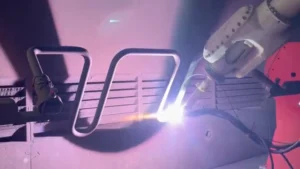table of contents
- Heading 1
- Heading 1
- Heading 1
share this
In the early stages of Covid-19, many countries were not well equipped to combat the virus. Besides the existing work medical staff had, they also had to cope with the pandemic, which placed them at a higher risk due to increased exposure. Hence, the medical industry began to turn to robots as an alternative solution.
There has been considerable contention on the usage of robots and their purpose in the workplace. Robots are commonly associated to threaten the workforce as jobs have been increasingly automated. However, with the global pandemic expected to last till the end of 2021 or longer, robots would alleviate the stress of the medical industry instead. Some key areas where robots are assisting include clinical care, logistics and manufacturing automation.
See below for areas where robots have been integrated.
Usage of Robots: Clinical Care
In clinical care, robots deployed to disinfect hospitals and wards used UV light technology. Similarly, they also used image recognition algorithms to detect potential cases. Integrating robotic systems in medical practices has become increasingly common, especially in medical screening and surgery. With these systems in place, it reduces the exposure of medical staff to contaminated surfaces.
With the help of telemedicine, there was a reduction of contact between healthcare workers and those who may transmit Covid-19. Using robots and other means of remote communication reduced the exposure of the virus to the healthcare workers, which meant that they could continue to do their work to help combat the spread of Covid-19. [1]
Here are a few examples:
In the Northern city of Shenyang, there was a rise in cases in the surrounding province, which lead authorities to seek alternatives and faster detection measures. Therefore, robotic arms were implemented to conduct throat swabs to reduce infection between people. This was done with a human colleague in a hazmat suit who controlled the robot’s movements from a safe distance away. [2]

Automated swab robot taking a throat sample in Denmark
Somewhere in Europe, Danish doctors and engineers from the University of Southern Denmark and Lifeline Robotics have also created a robot to reduce exposure between healthcare workers and the virus. It is a fully automated swab robot that uses computer vision and machine learning to identify an ideal spot inside a throat. A robotic arm with a long swab then reaches in to collect the sample. [3]
Alexandra Hospital in Singapore has also been using a robot called BeamPro to deliver medicine and meals to patients diagnosed or suspected with Covid-19 in its isolation wards. Doctors and nurses can control the robot by using a computer from outside the room and hold conversations with the patient via the screen and camera. [4]
“The robot reduces the number of touchpoints with patients who are isolated, thereby reducing risk for healthcare workers,” the hospital’s health innovation director Alexander Yip told local news channel CNA.
In preparation for the upcoming Tokyo Olympics, Japan is also exploring similar ways to automate Covid-19 tests. The robot system, built by Kawasaki Heavy Industries, is a prototype Covid-19 testing machine that uses a robotic arm to take a sample from a nose and deliver the results in 80 minutes. With an expected number of 11,000 athletes, keeping the pandemic under control is the government top priority during the games. By automating swab tests, helps to preserve and protect medical manpower and improve Covid-19 testing efficiency. [5]
Usage of Robots: Logistics and Manufacturing
In addition to social distancing, Bastian Solution integrates robot arms by ABB and FANUC into their automated storage and retrieval technologies. It eliminates high touch surfaces by having human pickers log in to individual workstations, which are apart from one another. [6]

Japan minister watching a demonstration of a prototype Covid19 testing machine
India-based Aurolab, which manufactures cataract surgery kits and intraocular lenses, has partnered with Universal Robots to optimize manufacturing processes utilizing collaborative robots. The cobots perform tasks such as material handling and careful picking and moving of the components — pivotal for the delicate process of manufacturing the lenses. After introducing eight cobots, Aurolab has seen a 15% increase in product output. [7]
Final Thoughts
In the future, robots will be progressively more autonomous and adaptable, improving functionality in other industries. Even though most robots require human supervision and will take some time before complete automation is achieved, the experience gained from these deployments will pave the way for more capable robots.
Follow Augmentus on Linkedin, Facebook to be updated for future insightful posts like these.
About Augmentus
Augmentus offers a no-code and fully-integrated robotic programming software that enables anyone, even those with no robotic experience, to program dynamic industrial robots in minutes. Our proprietary technology incorporates an intuitive graphical interface on an iPad that eliminates the need for coding and CAD files in robot teaching. Companies using Augmentus have experienced up to 70% cost reduction and 17 times faster deployments across a wide variety of applications, such as spraying, palletizing, welding, and inspections. Augmentus ushers in a new era of human-machine interface, democratizing robotic automation.
Book a demo now to experience it.
References
- [1] Coronavirus funding bill includes a new push for remote healthcare
https://www.theverge.com/2020/3/6/21166477/coronavirus-funding-bill-telehealth-remote-medicare-funding - [2] ‘Say ahh’: Chinese robots take throat swabs to fight Covid outbreak
https://medicalxpress.com/news/2021-01-ahh-chinese-robots-throat-swabs.html - [3] How Robots Became Essential Workers in the COVID-19 Response
https://spectrum.ieee.org/robotics/medical-robots/how-robots-became-essential-workers-in-the-covid19-response - [4] Robot to deliver meals, medication to Covid-19 patients at Alexandra Hospital to reduce exposure of healthcare workers
https://www.todayonline.com/singapore/robot-deliver-meals-medication-covid-19-patients-alexandra-hospital-reduce-exposure - [5] Olympics: Japan eyes use of robots to boost Covid-19 testing as Games loom https://www.straitstimes.com/sport/olympics-japan-eyes-use-of-robots-to-boost-covid-19-testing-as-games-loom
- [6] Reducing COVID Risks with Robots
https://www.automate.org/industry-insights/reducing-covid-risks-with-robots - [7] How cobots support elimination of blindness from the world.
https://www.universal-robots.com/case-stories/aurolab/




